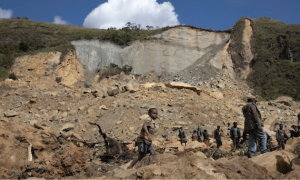
The local community from Yambani in Papua New Guinea assess the damage of the May 26, 2024, landslide. Credit: UNICEF
By Naureen Hossain
UNITED NATIONS, May 30 2024 – As the communities of Enga province in Papua New Guinea contend with the landslide that has devastated the residents of Yambani, the United Nations and its partners have been active on the ground addressing the immediate humanitarian needs, according to agencies.
Papua New Guinea’s prime minister, James Marape, says “extraordinary rainfall” and weather pattern changes were responsible for multiple disasters in the Pacific Island nation this year, including the landslide last Friday.
“Our people in that village went to sleep for the last time, not knowing they would breathe their last breath as they were sleeping peacefully. Nature threw a disastrous landslip, submerged or covered the village,” Marape told parliament on Wednesday.
Since the May 26 disaster, the United Nations has been actively supporting Papua New Guinea’s government in coordinating humanitarian support, search and rescue operations and the initial needs assessments of the thousands of locals who have been impacted by the devastating landslide. The UN is also coordinating the response efforts of all partners, both at the national and provincial levels, with the National Disaster Centre and the Enga Provincial Disaster Management Team.
UN agencies present on the ground to address immediate humanitarian needs include the International Organization for Migration (IOM) and the UN Development Programme (UNDP). UN-Women, UNFPA, and UNICEF are also coordinating with local emergency response teams to provide relief supplies, such as emergency health kits, tents, and psychosocial support.

Rescue efforts in Yambani, Papua New Guinea, after the May 26, 2024, landslide. Credit: UNICEF
UNICEF’s involvement has included the distribution of at least 50 hygiene and dignity kits, containing multipurpose cloth, soap, buckets, and reusable sanitary pads. They are also working to establish the broader needs of the affected communities, including child protection, health and sanitation, and nutrition needs.
“We are working closely with Papua New Guinean authorities and community organizations to provide vital support to the survivors of this terrible disaster,” said UNICEF Representative Angela Kearney.
“The challenges we face in the aftermath of this tragedy are immense,” said Serhan Aktoprak, IOM’s Chief of Mission in Papua New Guinea. “The area remains extremely dangerous due to ongoing land movement, and access is hindered by blocked roads, damaged infrastructure, and adverse weather conditions.”
The total affected population is estimated at 7,849 individuals, according to their 2022 common roll. Among the population, at least 42 percent are children aged 16 years or younger. So far, only six bodies have been retrieved from the rubble, with the numbers likely to increase as rescue and recovery efforts continue. The death toll is likely to be high. However, no official number has been confirmed yet. Though earlier reports indicated that anywhere from 670 people to over 2,000 have perished,.
“While the death toll is expected to be high, we refrain from stating exact numbers until the search operations are completed,” Juho Valka, Head of Communications, UNDP PNG, told IPS by email. Valka further explained that, as a result of the landslide, a total of 150 structures are estimated to have been buried. Evacuation centers have been set up between both sides of the debris, which is up to 8 meters, or 26 feet, high.
Papua New Guinea’s National Disaster Centre made an official request for international assistance through a letter to the UN Resident Coordinator. The UN is expected to coordinate assistance from local partners and individual member states.
Authorities in the Enga province have also called on international assistance for the deployment of geotechnical engineers to conduct a geohazard assessment. As of Tuesday, Australia, one of the country’s closest neighbors, has sent over a disaster response team, which includes a geohazard assessment group. The Australian government has also pledged over 2.5 million Australian dollars in aid efforts.
The situation is not without its complications. On Tuesday morning, a bridge collapsed in the Western Highlands province, which cut off the main Highlands highways just before Enga. This has disrupted communications between Enga and the rest of the Highlands. An alternative route to Enga is through the Southern Highlands Highway, which adds an additional two-three hours in travel time. The PNG Defense Force is currently making an effort to fix the bridge as soon as possible.
There is also a growing concern over a disease outbreak, as underground water flowing downward will likely contaminate local drinking water sources. Furthermore, locals are worried over the possibility of a second landslide, and a further 8,000 people may need to be evacuated, as Aktoprak told the Associated Press.“If this debris mass is not stopped, if it continues moving, it can gain speed and further wipe out other communities and villages further down the mountain,” he said.
According to an AP report, a team of 40 military engineers and medical personnel reached Yambali village on Tuesday night to negotiate with the villagers to begin digging efforts. Heavy earth-moving equipment, such as excavators, is expected to reach the scene by Thursday. However, villagers are divided on whether to use heavy-grade equipment, fearing that this could potentially further damage the bodies of their buried relatives. Villagers have been using shovels and farming tools to find bodies, with some even using their bare hands to dig through deep mud and debris.
IPS UN Bureau Report